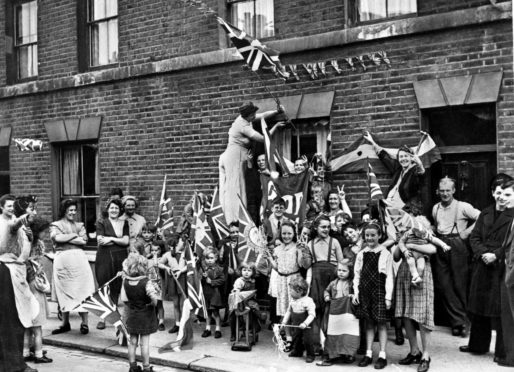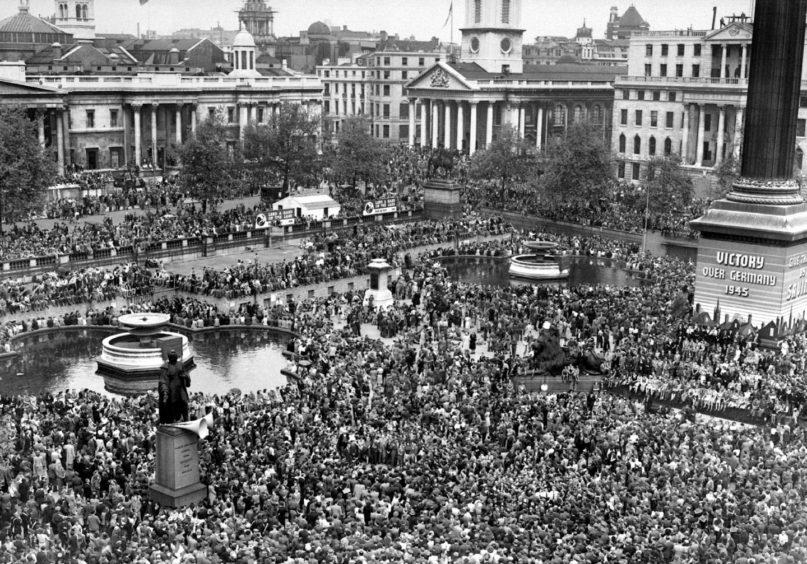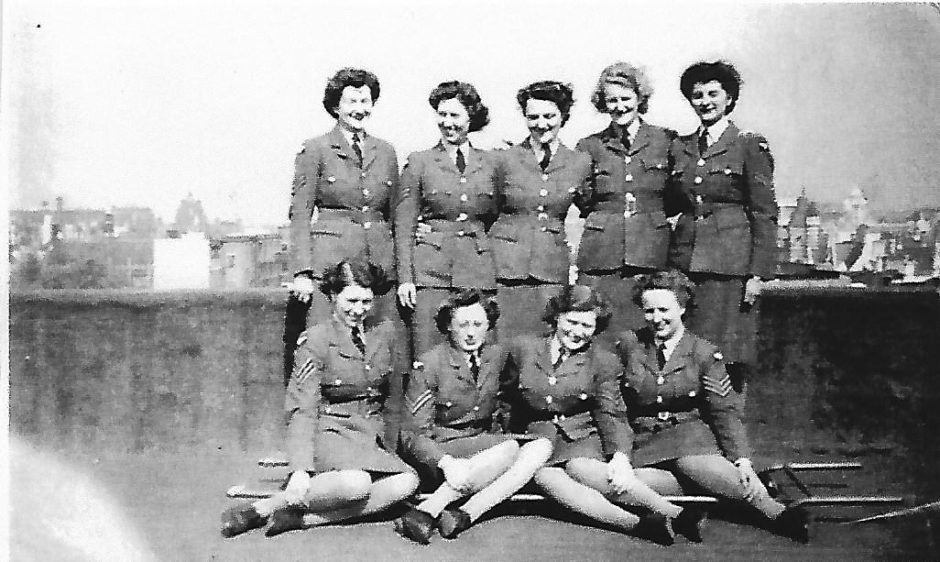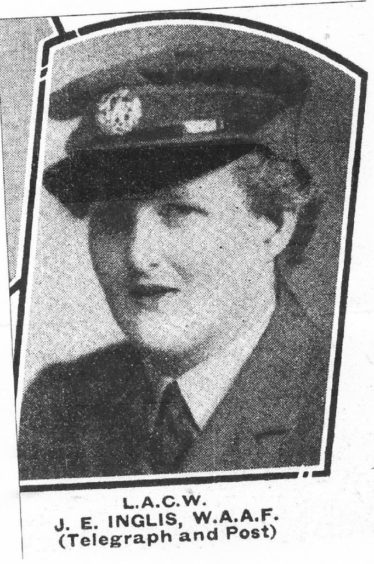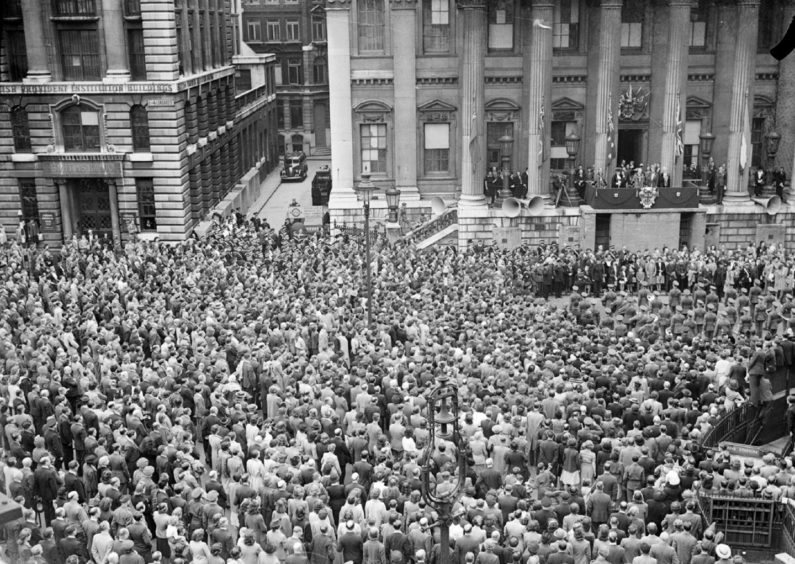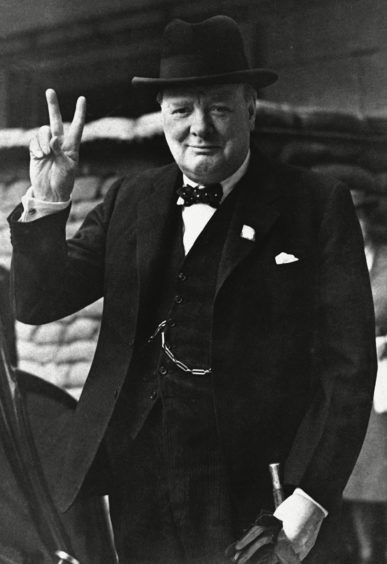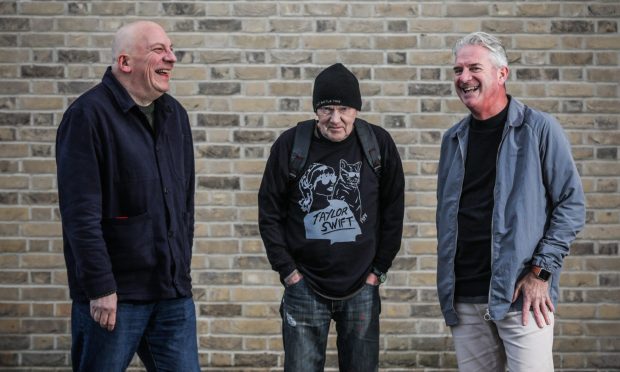She was the Dundee theatre critic who had a front row seat when the guns fell silent on World War Two.
Betty Forsyth (nee Inglis) from Broughty Ferry, who was known as Betty, was called up to the Women’s Auxiliary Air Force (WAAF) in 1942 and later worked at the Air Ministry in London.
Wartime memoirs
She listened intently as the King’s speech was relayed before celebrating the end of World War Two with tens of thousands of people in Trafalgar Square and Piccadilly in 1945.
She kept wartime memoirs which have now been shared by her daughters Valerie from Sussex and Sheila from Aberdeen to mark the 75th anniversary of the Allied victory over Nazi Germany.
Born in 1922 in Baldovie, she was educated at Dundee High School.
In 1933 the family moved to Fintry Place in Broughty Ferry to a house with electricity.
She joined DC Thomson in 1938 where she initially worked as a shorthand typist with the Evening Telegraph at Meadowside.
War broke out a year later and Miss Inglis said things changed dramatically and for the first time she was filled with a vague sense of impending doom.
Reputed brothel
“For the first time I began to notice whether or not the moon was shining, as its absence meant groping blindly in almost complete darkness,” she said.
“We were lucky enough to live in an area which received very little attention from the Luftwaffe.
“The firm for which I worked owned several warehouses and we had to take turns firewatching there, as well as in our own building.
“The girls only firewatched from 5-11pm and were then replaced by men who slept in the building.
“Our favourite supper was fish and chips but we did occasionally take in rather elaborate suppers to have a party with the men whose spell of duty followed ours.
“One warehouse shared an entrance with a reputed brothel, which added a little excitement to the boredom of firewatching.
“We cycled everywhere.
“The lack of signposts did cause us some awkward moments – especially on one occasion when a friend and I cycled one evening to see the wreckage of a German bomber which had crashed in a field about 15 miles away.
“We eventually found the spot and picked up some bits of shrapnel for souvenirs but got hopelessly lost on the way back.
“Darkness overtook us and we made our way back in convoy with one front and rear light between us.”
Theatre critic
She eventually found herself performing other roles for the Evening Telegraph when the men started getting called up, including being given the job of film and theatre critic for the first 10 months of 1942.
“The local variety theatre had a change of programme each week and I could anticipate with certainty that these songs would be sung: Bless this House; White Cliffs of Dover; and Apple Blossom Tree,” she said.
“Not being over fond of variety anyway, I found it rather hard always to find something complimentary to say.”
She was the first Tele girl to be called up when she joined the WAAF in 1942 and later she went on to work at the Air Ministry in London.
WAAFs did not serve as aircrew but were a vital presence in the control of aircraft, both in radar stations and as plotters in operation rooms, most notably during the Battle of Britain.
She married Alistair Forsyth shortly before the end of the war after meeting him when she was posted to Tain in Ross-shire and he was home on leave.
Borrowed shoes
“We decided to get married at very short notice – as luck would have it right at the end of a clothing coupon period,” she said.
“I had exactly seven coupons with which to provide myself with something to wear.
“I can’t remember the exact amounts required for each garment, but know that all I could buy new was a dress and gloves.
“A hat and handbag were coupon-free.
“I borrowed shoes and was lucky enough to be sent nylons from the United States.
“I remember thinking how wonderful it would be to walk into a store and buy stockings, without having to queue for hours, and then take what was offered with no choice of colour or thickness.”
A large proportion of the family’s rations were given to the local baker Goodfellows in order to get a very modest cake for the wedding without icing.
The morning of the wedding brought an unannounced bus strike in Dundee.
Taxis were few and the best man and some of the guests had to beg lifts to the church.
Best man was a relative
The best man was a relative as none of her fiance’s friends could get leave at such short notice.
Her memoirs also told how she was in London on VE Day and she recalled the unbelievable atmosphere of being among tens of thousands of people with some climbing on lampposts and riding on the tops of taxis.
“We all knew that the announcement of the end of the war in Europe was imminent,” she said.
“We went to Whitehall, Westminster and Buckingham Palace in the hope of victory being declared and eventually heard the announcement in the New Zealand Club.
“From there we went to Trafalgar Square and Piccadilly, where the atmosphere was unbelievable.
“Toilet rolls were streaming out of windows and everyone was talking to strangers, sharing the excitement of the news.
“There was no room to move and servicemen were clambering on top of vehicles completely jammed in by the crowds.
“It was a wonderful feeling to be right in the centre of London on such a night.”
On demob she briefly returned to DC Thomson to work on a part-time basis before raising her children with her husband in Broughty Ferry.
The couple had two daughters, six grandchildren and seven great-grandchildren.
Return to work
When the girls were older she went back to work, firstly with the Sunday Post on the help page where readers’ letters were answered, then as a legal secretary to a company in Dundee, before becoming the secretary to the Professor of Child Health in Dundee.
She first worked from offices in Dudhope Terrace then out to Ninewells Hospital.
After retirement she worked two mornings a week giving secretarial assistance to the Rector of St Mary’s Church in Broughty Ferry.
Daughter Valerie said: “This church meant a great deal to Betty as her grandparents were founder members and her father had the distinction of singing in the choir for over 70 years.
“He remembered the Tay Bridge Disaster as he was coming home from choir practice on that night.
“Betty was a shy, reserved lady who loved books and her garden and she said she did not know what boredom was.
“She was well-read and her command of English was superb.
“She was a wonderful cook and designed the most incredible hand-knitted jumpers for the family.
“Betty was well-respected and adored by all her family.
“The tributes to her after she died were very special and I do not think she would have been aware of how highly regarded she was.
“She was an unassuming, wise and respected lady.”
She died aged 89.
